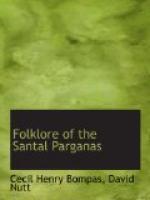Once upon a time there was a poor woman whose husband died suddenly from snake bite, leaving her with one little girl. At the time she was expecting another child and every day she lamented the loss of her husband and prayed to Chando that the child she should bear might be a son: but fresh troubles came upon her, for when her husband’s brothers saw that she was with child they declared that she had been unfaithful to her husband and had murdered him to conceal her shame: and although they had no proof of this, they seized on all their dead brother’s property and land and left the widow nothing but the bare house to live in.
But Chando had pity on her and when her time was full a boy was born to her. She gave thanks to Chando and devoted herself to bringing up the child. The boy grew up and learned to walk and talk and one day he asked his mother where his father was. She told him that a snake had bitten his father before he was born. Thereupon the boy embraced her and told her not to cry as he would support her and take the place of his father. The mother was filled with wonder and gratitude at the boy’s intelligence.
In answer to her daily prayers she met with kindness at all hands: when she went out working her employers gave her extra wages: when she went gleaning something extra was left for her, and if she had to beg no one refused to give her alms, so in time she was able to get together some household requisites and start keeping fowls and pigs. By selling these she saved enough money to buy goats and sheep: and in course of time was able to think of buying a cow.
By that time her son—whom she called Bhagraihad grown up to be a boy and took an interest in all that went on: so he asked his mother how he could tell when to buy a heifer. She said that if when the seller was showing a cow to an intending purchaser the animal dropped dung, it should be bought without hesitation, as such a cow was sure to take kindly to its new home and to have plenty of calves: another equally good sign was if the cow had nine teeth. Thereupon Bhagrai declared that he would set out to buy a cow and be guided in his choice by these signs and not come back till he found one. His mother thought that he was too young to undertake such a business but at last yielded to his entreaties. Then he tried to get some one in the village to go with him on his expedition but no one of his own friends or relations would go, so he had to arrange with a man of the blacksmith caste to keep him company.
Early one morning they set out, enquiring as they went along whether any one had a cow for sale. For a long time they were unsuccessful but after passing right through the territories of one Raja, they at length came to a village where they heard of a heifer for sale. As they were examining it it dropped dung, and on inspection its mouth showed nine teeth. Bhagrai at once declared that he must buy it and would not listen to the blacksmith who tried to dissuade him because, although the animal was full grown, it had had no calf and was probably barren. Bhagrai however preferred to be guided by the signs of which his mother had told him, and after a certain amount of haggling bought the animal for five rupees. The money was paid and he and the blacksmith set off homewards with the cow.




